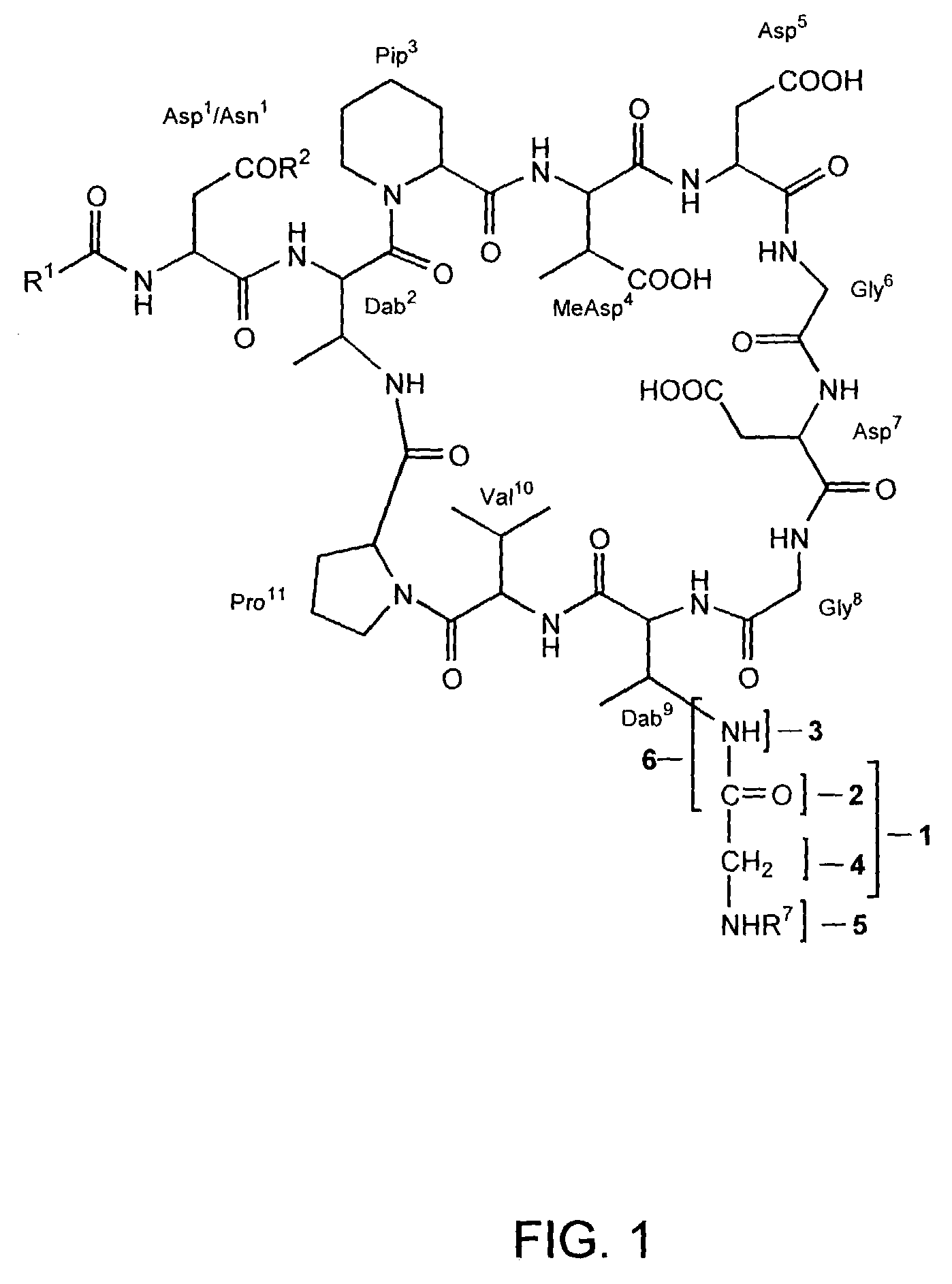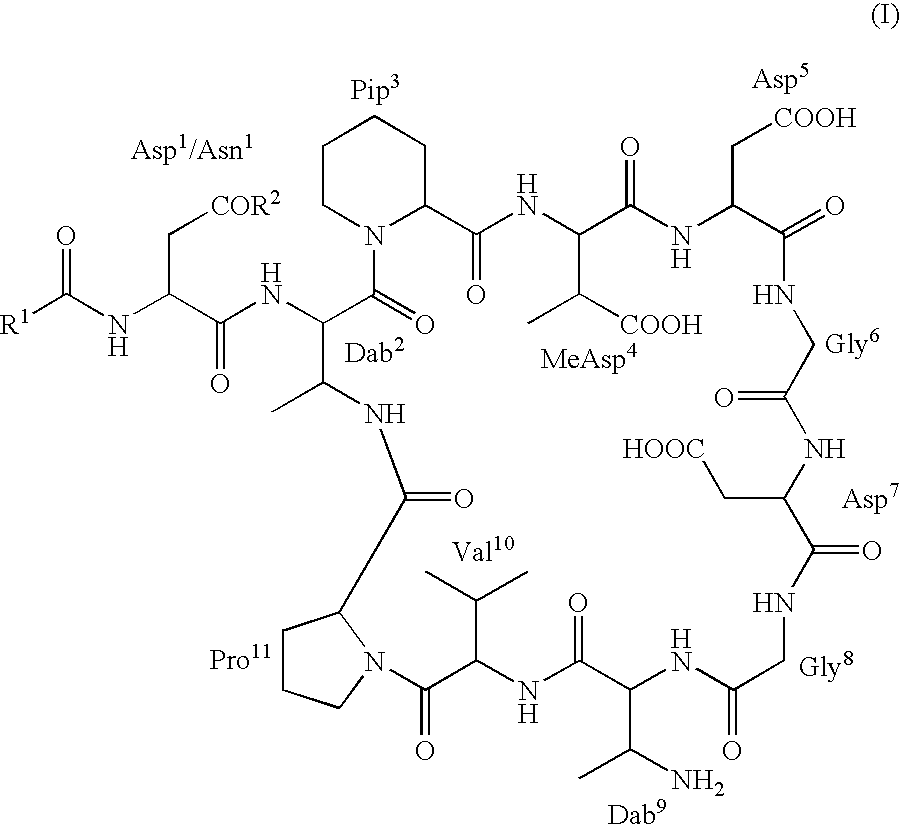Dab9 derivatives of lipopeptide antibiotics and methods of making and using the same
a technology of lipopeptide and derivatives, which is applied in the direction of antibacterial agents, peptide/protein ingredients, drug compositions, etc., can solve the problems that the effective control of enterococcus /i> is particularly difficult, and achieves the effect of inhibiting the growth of microorganisms
- Summary
- Abstract
- Description
- Claims
- Application Information
AI Technical Summary
Benefits of technology
Problems solved by technology
Method used
Image
Examples
example 1
Compound Synthesis
[0156]A number of Dab9 derivatives of aspartocin were prepared according to Scheme (I) from cultured aspartocin, both with and without prior separation and isolation of the various fatty acid fractions. In the nomenclature used herein, “natC14” designates the isolated C14 fatty acid fraction of the indicated compound and “natC15” designates the isolated C15 fatty acid fraction of the designated compound. The substituent R6 attached to the β-amino group of the macrocyclic Dab9 residue follows the name of the parent amphomycin-type lipopeptide antibiotic (in parentheses).
Fermentation of Aspartocin in a Bioreactor
[0157]The aspartocin complex was produced by fermentation in a 700-liter stainless steel bioreactor. Biochemical synthesis of aspartocin is performed by inoculating a medium composed of 1.0% dextrose, 0.5% molasses, 1.0% Bacto Peptone, and 0.1% CaCO3 in 100 mL of tap water, with spore and mycelial scrapings from a slant of Streptomyces griseus ssp. spiralis (...
example 2
In Vitro Antimicrobial Activity
[0163]This Example demonstrates that the various Dab9 aspartocin derivatives synthesized according to the previous example exhibit significant antimicrobial activity against Gram-positive bacteria in in vitro assays.
Determination of MIC
[0164]Minimum Inhibitory Concentrations (MICs) were determined in the presence and absence of calcium according to the protocol described in Approved Standard M7-A3, supra. For measurements carried out in the presence of calcium, 4 mM CaCl2 was added to the media at the beginning of the assay.
Results
[0165]The results of the various assays are tabulated in TABLE 1, below. As can be seen from TABLE 1, the presence of primary and secondary amines spaced about 3–6 carbons from the Dab9 β-amine improves the activity of these antimicrobial compounds. Amino acid side chains are well tolerated and do not appear to decrease the antimicrobial activity of the compounds.
[0166]
TABLE 1MassCompoundMIC(μg / mL)1ObservedNo.Namew / Ca2+w / o Ca...
example 3
[0167]The in vivo efficacy of the compounds of the invention was demonstrated with compound 1272 in a mouse protection model.
Protocol
[0168]Preparation of Inoculum
[0169]An overnight culture of methicillin sensitive Staphylococcus aureus (“MSSA”; Smith strain) grown to stationary phase in brain heart infusion broth (BHI) was diluted 1000-fold and maintained at 37° C. in a shaking incubator. Approximately two hours later the culture was centrifuged and the pellet was washed with sterile phosphate-buffered saline (“PBS”). The washed pellet was then reconstituted in Mueller-Hinton Broth (“MHB”) to achieve the desired density of bacteria. A portion of the inoculum was plated on blood agar plates to determine colony-forming units (CFU) per milliliter.
[0170]Formulation
[0171]Compound IB-1272 was formulated immediately before dosing in aqueous vehicle containing 5% dextrose. Compound IB-756 (Aspartocin) was formulated in PBS or 5% dextrose and used as a positive control.
[0172]...
PUM
| Property | Measurement | Unit |
|---|---|---|
| Density | aaaaa | aaaaa |
| Density | aaaaa | aaaaa |
| Density | aaaaa | aaaaa |
Abstract
Description
Claims
Application Information
 Login to View More
Login to View More - R&D
- Intellectual Property
- Life Sciences
- Materials
- Tech Scout
- Unparalleled Data Quality
- Higher Quality Content
- 60% Fewer Hallucinations
Browse by: Latest US Patents, China's latest patents, Technical Efficacy Thesaurus, Application Domain, Technology Topic, Popular Technical Reports.
© 2025 PatSnap. All rights reserved.Legal|Privacy policy|Modern Slavery Act Transparency Statement|Sitemap|About US| Contact US: help@patsnap.com



